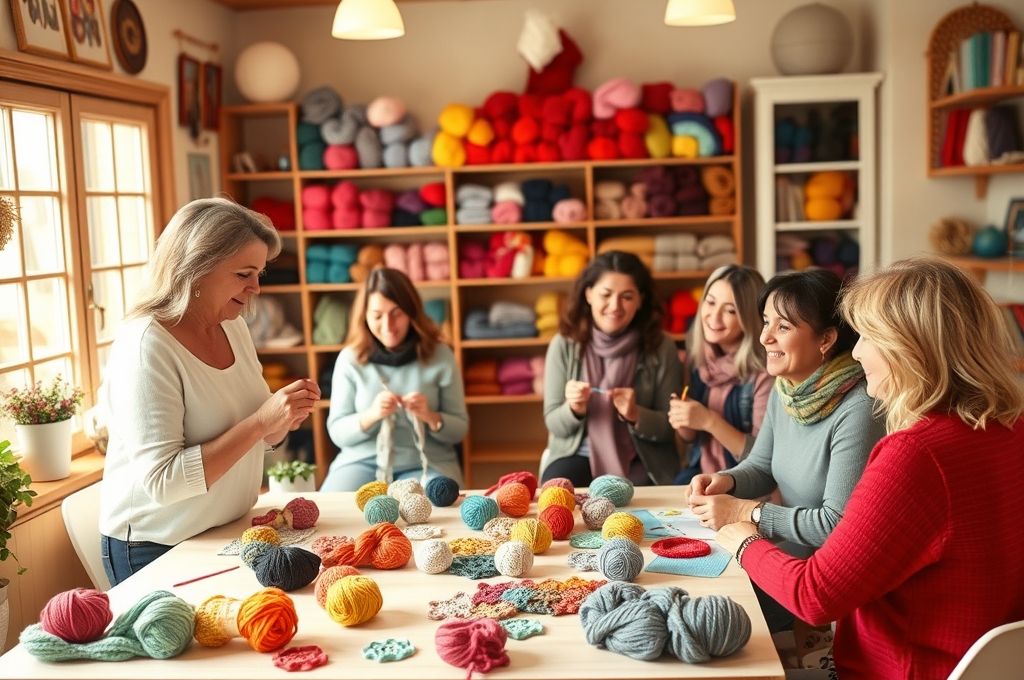The Joy of Teaching Crochet
Imagine a room filled with laughter, the soft click-clack of crochet hooks, and the warm satisfaction of watching someone create their first handmade stitch. Now imagine being the person who made that moment possible. Hosting crochet workshops isn’t just about teaching a craft—it’s about sharing a passion, building community, and empowering others with a skill that brings joy, mindfulness, and creativity into their lives.
Crocheting has seen a powerful resurgence in recent years. According to a 2023 survey by the Craft & Hobby Association, over 18 million Americans engage in crochet regularly—many of them beginners eager to learn. This growing interest presents a unique opportunity: if you love crocheting, why not share your knowledge through workshops? Whether you’re a seasoned crafter or someone who’s mastered a few key stitches, hosting a workshop allows you to connect, inspire, and even generate extra income.
In this article, we’ll explore how to plan, promote, and host a successful crochet workshop. From choosing your audience and designing your curriculum to creating a welcoming environment and turning your passion into a side hustle, you’ll discover practical steps to bring your vision to life. We’ll also look at real-life examples, common pitfalls to avoid, and how teaching can deepen your own love for the craft. Let’s unravel the yarn and get started.
Why Hosting Crochet Workshops Matters
At first glance, crochet might seem like a simple hobby. But dig a little deeper, and you’ll find it’s much more than that. It’s a form of self-expression, a meditative practice, and a way to build meaningful connections. When you host a crochet workshop, you’re not just teaching people how to loop yarn—you’re offering them a chance to slow down, focus, and create something tangible with their hands.
Studies have shown that engaging in crafts like crochet can reduce stress, improve mental focus, and even help with symptoms of anxiety and depression. A 2022 study published in the Journal of the American Art Therapy Association found that 75% of participants reported lower stress levels after just 20 minutes of crocheting. When you host a workshop, you’re contributing to mental wellness in a quiet but powerful way.
But the impact goes beyond individual benefits. Workshops create community. They bring together people from different backgrounds who share a common interest. Think about it: a retired teacher, a college student, and a busy mom might not cross paths in daily life—but in your workshop, they’re all learning side by side. That shared experience fosters connection, conversation, and support.
Moreover, teaching reinforces your own skills. Explaining techniques to others forces you to break down what you know, deepening your understanding. You’ll find yourself learning new ways to approach common problems and gaining fresh inspiration from your students’ creativity.
In short, hosting a crochet workshop isn’t just about passing on a skill—it’s about nurturing well-being, building relationships, and keeping a beautiful tradition alive.
Who Is Your Workshop For? Understanding Your Audience

Before you buy yarn or design flyers, ask yourself: Who am I trying to reach? Knowing your audience is the foundation of a successful workshop. Are you teaching complete beginners? Kids? Seniors? Experienced crocheters looking to level up? Each group has different needs, expectations, and learning styles.
For absolute beginners, keep things simple. Focus on basic stitches like the chain, single crochet, and slip stitch. Use large hooks and smooth, light-colored yarn—this makes it easier to see each stitch. Structure your session around a small, achievable project, like a coaster or a simple scrunchie. These quick wins build confidence and keep motivation high.
If you’re targeting teens or young adults, consider making the workshop more social and trendy. Think “Crochet & Coffee” nights or “DIY Accessory” classes where they can make phone straps or friendship bracelets. Incorporate modern patterns and bright, fun colors. Many young people are drawn to crochet as a form of self-care or a creative outlet from screen time.
For older adults or retirees, comfort and pacing are key. Offer chairs with good back support, plenty of breaks, and clear verbal instructions. Many seniors already have experience with crafts, so they may pick up techniques quickly. Projects like dishcloths, scarves, or granny squares can feel nostalgic and rewarding.
You might also consider themed workshops, such as holiday ornament making, baby blankets for charity, or pet toys. These add a special touch and attract people looking for a unique experience.
The more specific you are about your audience, the better you can tailor your content, materials, and teaching style. This not only improves the learning experience but also helps you market your workshop more effectively.
Planning Your Workshop: From Concept to Curriculum
Now that you know who you’re teaching, it’s time to plan what you’ll teach. A well-structured workshop flows smoothly and keeps participants engaged from start to finish.
Start by defining your goal. Is it to teach a specific skill? Complete a small project? Or simply introduce the basics in a fun, low-pressure way? For a 2-hour beginner workshop, a realistic goal might be: “By the end, everyone will be able to chain 20 stitches and complete a single crochet row.”
Next, break down your lesson into clear steps:
- Welcome and introductions (10 minutes)
- Overview of tools and materials (15 minutes)
- Hands-on practice: making a slip knot and chaining (20 minutes)
- Learning the single crochet stitch (30 minutes)
- Practice and troubleshooting (30 minutes)
- Wrap-up and next steps (15 minutes)
This structure gives a natural rhythm to the session. It starts with connection, moves into learning, allows time for practice, and ends with encouragement.
Choose a simple, repeatable project that fits your time frame. A rectangle coaster, a heart-shaped keychain, or a mini amigurumi animal are all great options. Make sure the pattern uses only 1–2 stitches and doesn’t require complex shaping.
Prepare a materials list and decide whether participants will bring their own supplies or if you’ll provide them. Offering kits (hook, yarn, tapestry needle, pattern) for a small fee adds convenience and can even become a source of income.
Finally, test your lesson yourself. Run through the entire workshop alone or with a friend. Time each section, note where confusion might arise, and adjust accordingly. This rehearsal will boost your confidence and ensure everything runs smoothly on the big day.
Creating a Welcoming and Inclusive Environment
Crochet can feel intimidating to beginners. The jargon (“yarn over,” “insert hook,” “pull through”) might sound like a foreign language. That’s why the atmosphere you create matters just as much as the skills you teach.
Start by setting the tone. Greet everyone with a smile. Use simple, encouraging language. Say things like, “There’s no such thing as a wrong stitch—only a unique one,” or “We’re all learning here, so don’t worry about mistakes.”
Arrange the space to encourage interaction. Use round tables or a U-shape setup so everyone can see you and each other. Play soft background music—acoustic, folk, or lo-fi beats work well. Offer tea, water, or snacks if possible. These small touches make people feel cared for and relaxed.
Be mindful of accessibility. Choose a venue that’s wheelchair accessible, well-lit, and has comfortable seating. If you’re using digital materials, provide printed copies as well. Speak clearly and check in regularly: “Is everyone following okay? Any questions so far?”
Encourage peer support. Pair up beginners with more confident learners, or create “buddy groups.” You’ll often find that participants help each other, which builds camaraderie and reduces pressure on you as the instructor.
And remember: mistakes are part of the process. When someone drops a stitch or knots their yarn, laugh it off. Share your own early crochet disasters—like the time you made a scarf that spiraled into a corkscrew. Humor and humility go a long way in making people feel safe to learn.
When people feel welcomed and supported, they’re more likely to return, recommend your workshop, and keep crocheting long after the session ends.
Marketing Your Workshop: Getting the Word Out

You’ve planned a fantastic workshop—now how do you fill the seats?
Start by defining your unique selling point (USP). What makes your workshop special? Is it beginner-friendly? Eco-friendly (using sustainable yarn)? Held in a cozy café? Focused on mindfulness? Highlight this in all your messaging.
Use local channels first. Post flyers at libraries, coffee shops, craft stores, and community centers. Talk to your local yarn shop—they might let you host the workshop in-store or promote it to their customers.
Leverage social media. Create a Facebook event, post on Instagram with before-and-after photos of projects, and join local community groups. Short videos showing a quick stitch tutorial or a behind-the-scenes look at your prep can generate interest.
Consider collaborating with others. Partner with a yoga studio for a “Stitch & Stillness” event, or team up with a bakery for a “Crochet & Cupcakes” afternoon. Cross-promotion expands your reach and adds novelty.
Pricing is another key factor. Will your workshop be free, donation-based, or paid? If charging, be transparent. A typical beginner workshop might cost $25–$40, which often includes materials. Offer early-bird discounts or group rates to encourage sign-ups.
Finally, collect emails (with permission) to build a mailing list. Send a thank-you note after the event, include a free mini-pattern, and invite them to your next session. This turns one-time attendees into loyal followers.
Common Challenges and How to Overcome Them
Even the best-planned workshops can hit snags. The good news? Most challenges are predictable—and fixable.
One common issue is uneven skill levels. You might have one person who’s never held a hook and another who’s been crocheting for years. To handle this, offer “challenge options.” For example, while beginners work on single crochet, more advanced participants can try double crochet or add a border. This keeps everyone engaged without slowing down the class.
Time management is another hurdle. It’s easy to spend too long on one section and rush the rest. Use a timer during your practice run and stick to it. If you notice people struggling, offer to send extra help via email or a follow-up video.
Yarn confusion happens more than you’d think. Different brands, weights, and colors can be overwhelming. Stick to one type of yarn for the workshop—preferably a medium-weight (worsted) acrylic in a light color. Label everything clearly and have extras on hand.
What if no one shows up? It’s discouraging, but it happens. Don’t take it personally. Follow up with registered attendees a day before, and consider hosting a smaller “friends & family” version to test your format. Use the experience to improve your marketing next time.
Lastly, your own nerves. Even experienced teachers get anxious. Remind yourself: you don’t have to be perfect. You just have to be present, kind, and helpful. Breathe, smile, and trust that your passion will shine through.
Turning Passion into Profit: Monetizing Your Workshops
While sharing your love of crochet is rewarding on its own, there’s nothing wrong with earning a little (or a lot) from your efforts. In fact, monetizing your workshops can help sustain your craft and allow you to reach more people.
Start small. Charge a modest fee that covers materials and your time. As you gain confidence and positive feedback, you can increase your rates or offer premium options—like private lessons, advanced classes, or themed kits.
Sell project kits after the workshop. For example, offer a “Next Step” kit with yarn, hook, and a pattern for a beanie or market bag. This not only generates income but also encourages continued learning.
Explore online workshops. Platforms like Zoom or Teachable let you reach a global audience. Record your sessions and sell them as on-demand courses. While in-person events build community, online classes offer scalability and passive income.
You might also consider sponsoring or partnerships. Local businesses may sponsor a workshop in exchange for branding—like a café hosting your event in return for promotion. Yarn companies sometimes provide free materials for educators in exchange for social media shoutouts.
And don’t forget merchandise. Simple items like branded project bags, stitch marker sets, or downloadable pattern bundles can become additional revenue streams.
Remember: charging for your knowledge doesn’t diminish its value—it affirms it. You’re offering time, expertise, and care. You deserve to be compensated.
Inspiring Stories: Real People, Real Impact
Let’s take a moment to meet Sarah, a nurse from Portland who started hosting crochet workshops at her local senior center. She noticed many residents felt isolated, especially after losing spouses or dealing with health issues. Her “Stitch & Chat” group began with just three people. Today, it has 18 regular members.
“I didn’t realize how much they looked forward to it,” Sarah says. “One woman told me, ‘This is the only time all week I feel like I’m doing something just for me.’ That hit me right in the heart.”
Then there’s Marcus, a college student in Chicago who turned his crochet hobby into a campus club. He started with a pop-up table in the student union, teaching basic stitches. Now, “Crochet Crew” has over 50 members and hosts charity drives, making blankets for homeless shelters.
And let’s not forget Ana, a retired teacher in Miami who launched an online course after her in-person workshop went viral on TikTok. She now earns over $2,000 a month from her crochet tutorials and digital patterns.
These stories aren’t outliers. They show that anyone—regardless of age, background, or skill level—can make a difference by sharing what they love. You don’t need a huge following or a fancy studio. You just need a heart to teach and a willingness to start small.
Beyond the Workshop: Building a Lasting Community
A single workshop is a beautiful beginning—but the real magic happens when connections continue to grow.
Consider starting a monthly meetup or stitch-along. These recurring events keep the momentum going and help participants build confidence over time. You might theme them—“Color Challenge Month” or “Gift-Making Sprint”—to keep things fresh.
Create a private Facebook group or WhatsApp chat for your students. Share tips, answer questions, and celebrate finished projects. This digital space becomes a support network where people encourage each other.
Host charity projects. Organize a blanket drive for a women’s shelter or make hats for premature babies at a local hospital. Giving back deepens the sense of purpose and unites the group around a common cause.
You might even train others to teach. As your group grows, identify passionate learners who could co-lead or host their own mini-sessions. This multiplies your impact and fosters leadership within the community.
Over time, your workshop can evolve into something much bigger—a circle of creativity, care, and connection that extends far beyond a single afternoon of crocheting.
Conclusion: Your Hands Can Change Lives
Hosting crochet workshops is about more than teaching stitches. It’s about opening doors—inviting people into a world of creativity, calm, and connection. Every loop of yarn, every shared laugh, every “I did it!” moment adds up to something meaningful.
You don’t need to be an expert. You don’t need a perfect studio or a huge audience. You just need a passion for crochet and a willingness to share it. The rest will grow from there.
So take that first step. Plan your first workshop. Invite a few friends. Put up a flyer. Start small, stay kind, and keep showing up.
And remember: the skills you’re teaching today might become someone’s lifelong hobby, stress reliever, or even a new career. You never know whose life you might change—one stitch at a time.
Now, over to you: Have you ever taught a craft to others? Are you thinking about hosting your own crochet workshop? Share your story or your dream project in the comments below. Let’s inspire each other to create, connect, and crochet on.

Daniele Ferreira is passionate about the world of crochet, dedicating her time to exploring techniques, creating unique pieces, and sharing her knowledge with beginners and aficionados alike. With attention to detail and creativity, she transforms yarn into true works of art, inspiring others to discover the beauty and joy of this manual art.







